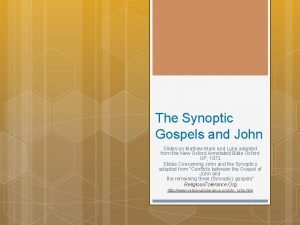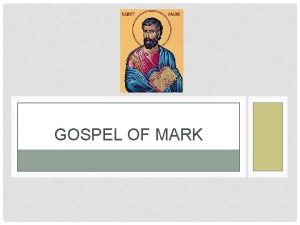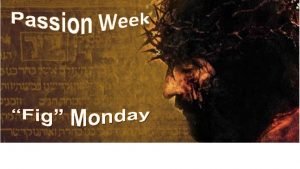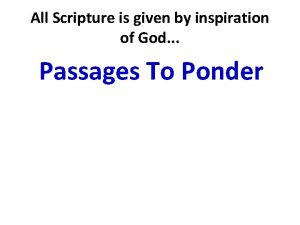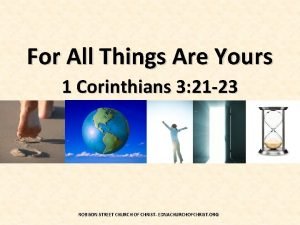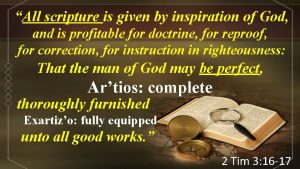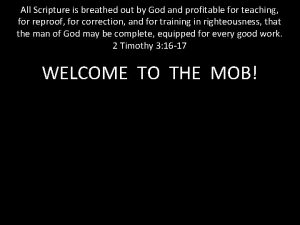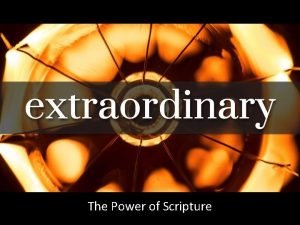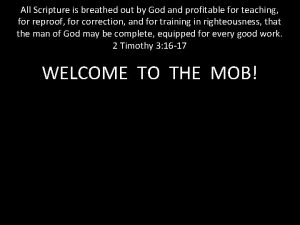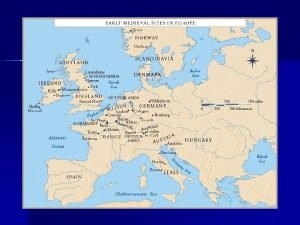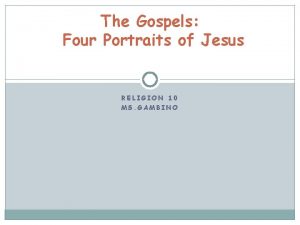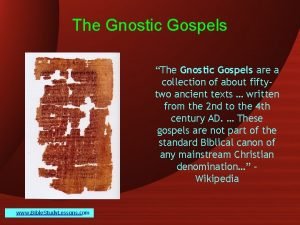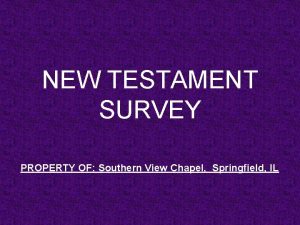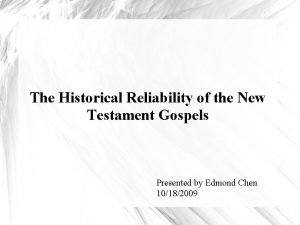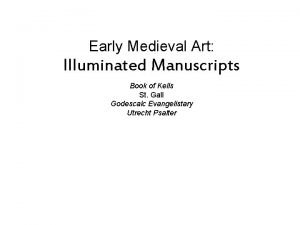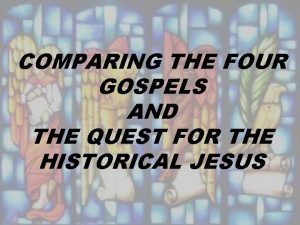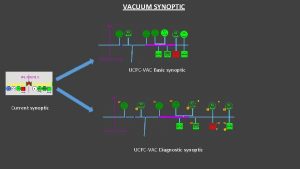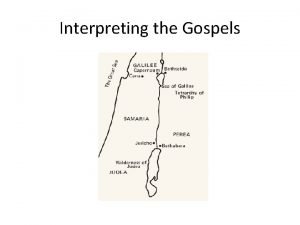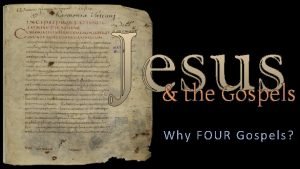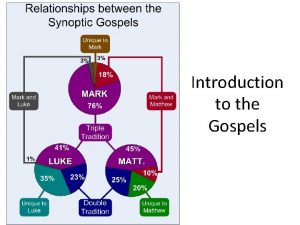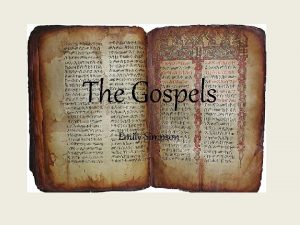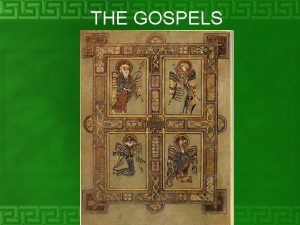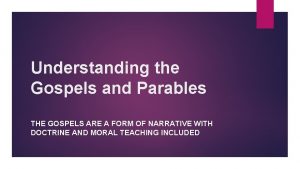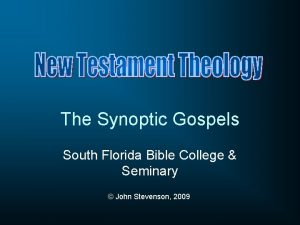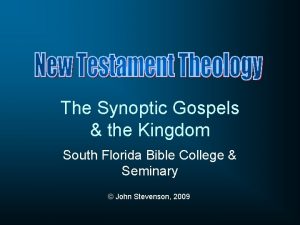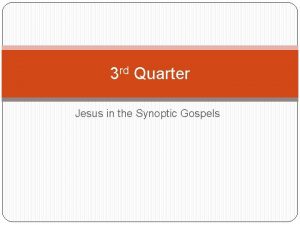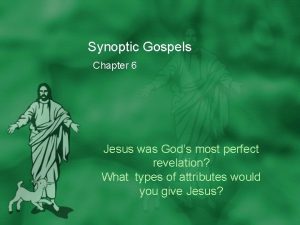THE SYNOPTIC GOSPELS The Heart of All Scripture




















- Slides: 20

THE SYNOPTIC GOSPELS The Heart of All Scripture

The Gospels The generations of the covenants, the kings, and the prophets had come to a close with the Incarnation of the Son of God. The Incarnation is the historical event of the Son of God taking on our human nature to save us from sin and death. The Incarnation, Life, Death, Resurrection, Ascension & the sending of the Holy Spirit by Christ are written of in the Gospels. The word Gospel comes from the Greek word εὐαγγέλιον (euaggelion) and means “good news”. The Gospels are the “good news” of Jesus Christ, specifically the good news of our salvation. It is because of the important message of salvation contained within the Gospels that they are the heart of the Scriptures. The Gospels are to be studied and venerated (loved) more than the other Holy Scriptures because they tell of God’s love for us in becoming man and giving His life on the Cross to save us. There are four Gospels: Matthew, Mark, Luke, and John.

The Evangelists An Evangelist is one who actively spreads the Word of God St. Matthew St. Luke St. Mark St. John

The Synoptic Gospels q Matthew, Mark, and Luke are called synoptic Gospels. “Synoptic” comes from the Greek for “seeing the whole together”. Matthew, Mark, and Luke are synoptic because they share a similar style and content. The Gospel of John is called by some as “non-Synoptic” but this term does not identify what the Gospel of John is in terms of composition. The Gospel of John is a theological Gospel in that John uses the historical account of Christ’s life and inserts his own inspired theological explanation of the meaning of the events. He uses the story of Christ’s life to explain the doctrines which Christ taught and are necessary to the Christian faith (ex. the Eucharist). The Gospels were formed over the course of several decades and through a process of formation. The Life and Teaching of Christ The Oral Teaching and Preaching of the Apostles The Written Tradition

The Gospel of Matthew q Matthew’s Gospel was written around 50 AD. q Probably written over several years at Antioch, a Christian community with a mix of Jewish and Gentile Christians. q Matthew’s Gospel has a Jewish focus: he frequently uses Aramaic expressions, quotes from the Old Testament, details Jewish religious observances, and uses a Jewish writing style. The Call of St. Matthew by Caravaggio q The focus of Matthew’s Gospel is on: illustrating Jesus as Messiah, as the fulfillment of the law, and the

The Jewish Jesus Matthew’s Gospel focuses on many of the Jewish expectations of the Messiah, and it highlights the conflict between Jesus and the Scribes and Pharisees. The Scribes were the secretaries of Pharisees, they were learned men who copied the Holy Books and interpreted and taught the Law. The Pharisees were a ruling class of Jewish leaders who taught a strict adherence to the Law of Moses. Throughout Matthew’s Gospel Jesus often clashes with the Pharisees over the “heart of the Law”. Chapter 5 and 6 of Matthew provide us with Jesus’ “upgrade” of the Law. The “Sermon on the Mount” in Mt. 5, contains the Beatitudes – the Beatitudes overturn the mistaken attitude of the Pharisees who kept the Law by the letter but not in their hearts. Jesus calls on His disciples to fulfill the “heart of the Law”. An example of this is in Mt. 5: 21 -22, 27 -28, Jesus says: “You have heard it said ‘you shall not murder … you have heard it said ‘you shall not commit adultery. ” Jesus calls on His disciples to cut out sin at the roots and truly fulfill the Law, “But I say to you that everyone who is angry with his brother is guilty

The Gospel of Mark q Mark’s Gospel was written by John Mark, a follower of St. Paul and later St. Peter (see I Pt. 5: 13). q. His Gospel is written between 65 -70 AD for Roman Christians. q Some key themes in Mark include: Jesus as the suffering Servant, the Messianic secret, and discipleship. q. The image of Jesus as the “Suffering Servant” was an important image for persecuted Christians. q The Messianic Secret = refers to Jesus telling his disciples to keep His identity as

The Gospel of Luke q The Gospel of Luke was written by Luke, a follower of St. Paul and a gentile convert to the faith. q. A physician by trade, Luke’s Gospel was probably written between 70 -80 AD in Asia Minor. q Some key themes in Luke are: the universality of the Gospel, the activity of the Holy Spirit, prayer, and Christ’s call to repentance. q Another key aspect of Luke is his focus on women, especially the Blessed Mother. St. Luke by El Greco q. Luke’s Gospel contains a detailed account of the Annunciation, Visitation, and Nativity. Luke reveals Mary as a model of faith and co-worker with the

Why did it take so long? � Lets say that Matthew is the earliest Gospel at 50 AD and Luke is the latest synoptic Gospel at 80 AD, not to mention John’s Gospel written in about 96 AD – Jesus dies in about 33 -35 AD … so what took so long? � Consider the following historical obstacles: 1. By 35 -39 AD Saul led the persecution of Christians and was responsible for the martyrdom of St. Stephen. 2. In 41 AD Herod Agrippa ordered the persecution of Christians, Peter narrowly escapes and the disciples flee. 3. 37 -68 AD – the persecution of Roman Christians under the Emperor Nero. 4. 89 -96 AD – persecutions under Domitian. 5. The travels of the apostles were not conducive to writing. Basically we were good at two things … &

Central Accounts in the Synoptic Gospels To get a flavor of the synoptic Gospels, lets look at the parallel stories within the synoptic Gospels and their theological importance to our faith: Infancy Narratives q. Matthew and Luke chronicle the birth of Christ. q. Luke pays special attention to Mary’s active roll in accepting God’s invitation at the Annunciation. Jesus’ Baptism q Jesus’ Baptism is attested to in all four Gospels and is called the Theophany. q There are many Theophanies in the Old Testament, but at Jesus’ Baptism all three Persons of the Trinity are in one place at one time. q. In Lk. 1 the angel Gabriel announces to Mary that she will be “overshadowed” by the Holy Spirit and bear a son Who will be Christ, the Lord. q This event reveals the fullness of God and gives rise to the sacrament of Baptism. q. Mary’s “fiat”/yes to God’s plan is necessary for the plan of salvation. q Think about it! Jesus is God, baptism washes away sin and Jesus has no sin. So why did He get baptized?

Jesus’ Ministry – Feeding Spiritual Hunger The Temptation q Before Jesus begins His ministry He journeys into the desert for fasting and prayers for 40 days. Feeding 5, 000 q All four Gospels contain the miracle of the multiplication of loaves and fishes. q While there He is tempted by the Devil three times. q Jesus took the bread, “He looked up to heaven, blessed, broke, and gave them to His disciples. ” Mk. 6: 41 q The first temptation challenges Jesus to turn stones into bread – Jesus refuses, He will not be a mere miracle worker. q The second temptation involves Jesus jumping from the pinnacle of the Temple and trusting the angels to catch Him – He refuses because we are not meant to tempt God. q The third temptation is to worship Satan – Jesus refuses, He is there q The parallel of this miracle to the Eucharist is undeniable, “And as they were eating, Jesus took bread, blessed, broke it, and gave it to them and said, ‘Take, eat; this is My Body. ” Mk. 14: 22 q As Moses fed the people in the wilderness with the manna; Jesus reveals Himself as the new Manna from heaven.

The Parables The Good Samaritan q. Jesus tells this parable in response to the question, “And who is my neighbor? ” q. A man is beaten and left for dead, a priest and a Levite walk by and do nothing. q. A Samaritan walks by and cares for the man. q. Jesus asks, “Who was neighbor to the man? ” Of course the Samaritan. q. The Samaritans were of mixed race, half Jew/half Gentile and therefore looked down upon. But Jesus calls on all to do the will of God regardless of nationality. The Prodigal Son q Luke’s Gospel tells the story of a wayward son who asks for his inheritance while his father is still living. q. In essence what does the son consider the father? q. The son goes off and loses everything, then he decides to return and attach himself as a slave to his father. q. Upon the son’s return the father runs to him and clothes him in a robe, a ring, and sandals. q. He orders the fatted calf killed and a feast in set in honor of the prodigal’s return.

Reconciliation In the sacrament of reconciliation the Father invites us to repentance and is always willing to show us mercy. In the sacrament not only are our sins forgiven, but God clothes us with His grace to sin no more. Christ gave His priests the authority to forgive sins in His Name, “And as He said this He breathed on them and said ‘receive the Holy Spirit, whose sins you forgive are forgiven…’” Jn. 20: 22

Making the Broken Whole All of Jesus’ miracles are centered around making people whole again … lets consider the four types of miracles: Healing Miracles Exorcisms Control of Nature q Jesus heals a leper: Mt. 8: 1 -4, Mk. 1: 40 -45 q Jesus heals the possessed: Mt. 8: 16, Lk. 4: 4041 q Jesus calms the storm: Mt. 8: 2327, Lk. 8: 22 -25 q Jesus heals a paralytic: Mt. 9: 1 -8, Lk. 5: 17 -26 q Jesus’ healing miracles are centered around making the physically broken whole again. q Jesus heals the boy with a demon: Mk. 9: 14 -29, Lk. 9: 37 -43 q Jesus’ exorcisms are centered around making the spiritually q Jesus walks on water: Mt. 14: 2233, Mk. 6: 45 -52 q Jesus shows His power to restore nature back to the original order of Genesis. Resurrection q Jesus raises Jairus’ daughter – Mk. 5: 21 -24, 53 -43, Lk. 8: 4042, 49 -56 q Jesus raises the widow’s son: Lk. 7: 11 -17 q Jesus reveals His divinity in His power over death.

Jesus’ Hour – The Passion of Christ q After the Last Supper, when Christ gave us His Body and Blood in perpetual connection which His death and Resurrection; Jesus went to the Mount of Olives. q He prayed, “Father let this cup pass” (Mt. 26: 39), here we see a very human Jesus frightened by His impending torture and death. q. Yet, He also prays, “. . not as I will, but as You will”. Jesus reminds us that even amid much suffering we are called to always be faithful to God’s will. The Agony in the Garden by El Greco q. Jesus reveals His great love and concern for us – He sweats blood.

The Cross – Our Salvation q The debt of humanity’s many sins caused a moral imbalance between God and man. q Natural justice demands that evil/wrong be punished to restore the balance of justice. q Christ took upon Himself the punishment which we merited through our sins. q He gave Himself on the Cross as the supreme act of the love of God for humanity. q Through the Cross our sins were forgiven and we are invited, through the grace of the Cross, to become more like God (theosis). The Crucifixion by Rembrandt

The Resurrection – The Proof of Christianity q According to the Jewish custom Jesus’ body needed to be anointed after the Sabbath had passed. q Some of Jesus’ female followers go to the tomb early on Sunday morn and find the stone rolled away and they did not find the Body of Jesus in the tomb (Lk. 22: 2 -3). q They witness an angel who asks them, “Why do you seek the living among the dead? He is not here, He is risen. ” (Lk. 22: 5 -6). q How do we know that He really rose? Could His Body have been taken and His followers only claimed that He rose? q Lets consider the facts …

The Resurrection – The Facts The Roman Guard of 4 -16 soldiers at the tomb (Mt. 27: 62 -66). The impossibility of Christ surviving the ordeal of scourging, crucifixion, and a spear to the heart. The post-Resurrection appearances to the apostles and to more than 500 at one time, attested to be Paul (I Cor. 15: 6)

The Martyrs St. Bartholomew St. Peter 212 St. Perpetua and Felicitas St. Stephen

The Ascension 5 The Ascension q 40 days after the Resurrection Jesus ascended into heaven. q. This event seems the natural conclusion to His Life, but we need to grasp the consequences of this event. q Consider, that heaven is the presence of God and God is spirit, therefore heaven is a spiritual place. q Jesus risen from the dead has a physical body, as is confirmed by the apostles, especially Thomas, and by the fact that He eats and drinks. q Jesus makes our human nature, our flesh and blood part of heaven. q The ascension points to humanity’s glorious completion in the resurrection and in “the life of the world to come. ”
 Synoptic gospels
Synoptic gospels Synoptic gospels
Synoptic gospels List the synoptic gospels
List the synoptic gospels Sunoptic gospels
Sunoptic gospels Is the triumphal entry in all four gospels
Is the triumphal entry in all four gospels Blessed are the pure in heart meaning
Blessed are the pure in heart meaning Scripture inspired by god
Scripture inspired by god All scripture is given by inspiration of god meaning
All scripture is given by inspiration of god meaning All things are yours scripture
All things are yours scripture All scripture is given
All scripture is given All scripture is breathed out by god
All scripture is breathed out by god All scripture is given by
All scripture is given by All scripture is breathed out by god
All scripture is breathed out by god Who commissioned the gero crucifix
Who commissioned the gero crucifix 4 portraits of jesus in the gospels
4 portraits of jesus in the gospels David e. pratte wikipedia
David e. pratte wikipedia Southern view chapel
Southern view chapel The virgins memo genius
The virgins memo genius Reliability of new testament
Reliability of new testament Chi rho iota page from the book of kells
Chi rho iota page from the book of kells Comparing the four gospels
Comparing the four gospels
